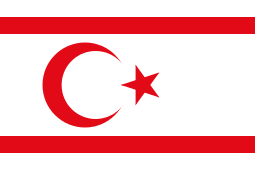Flag of Northern Cyprus
 | |
| Use | National flag and ensign |
|---|---|
| Proportion | 2:3 |
| Adopted | 1983 |
| Design | A red star and crescent slightly to the left of the center between two horizontal red bars on a white field. |
|
Variant flag of the Turkish Republic of Northern Cyprus | |
| Name | Flag of the President of the Turkish Republic of Northern Cyprus |
| Use | Other |
| Proportion | 2:3 |
|
Variant flag of the Turkish Republic of Northern Cyprus | |
| Name | Flag of the Turkish Republic of Northern Cyprus reportedly used 1983–84[1] |
| Use |
Other |
| Proportion | 2:3 |
| Design | As above, but with red and white inverted. A white star and crescent slightly to the left of the center between two horizontal white bars on a red field. |
The flag of the Turkish Republic of Northern Cyprus (Turkish: Kuzey Kıbrıs Türk Cumhuriyeti Bayrağı), a self-declared state since 1974, recognised only by Turkey, is based on the flag of Turkey with the colors reversed and two horizontal red stripes added at the top and bottom. It was the result of a competition to find a new representative flag for the TRNC. The local use of the Turkish flag is somewhat similar to the use of the Greek flag in the rest of the island.
Kyrenia Range
The Turkish and TRNC flags were drawn on the Kyrenia Mountains, facing south (35°16′58″N 33°22′31″E / 35.282902°N 33.375263°E). "Ne Mutlu Türküm Diyene" is written beneath the Turkish flag in white—an oft-repeated phrase of Kemalism.
In 2010 the Greek Cypriot side officially complained about the flag to the EU Commission, framed as an environmental hazard because of toxic materials used to trans-impose it into the mountain side that are liable to leakage. It is also considered by Greek Cypriots as offensive not only to the environment but also their own community and as an act of provocation.[2]
See also
References
- ↑ "Turkish Republic of Northern Cyprus". FOTW Flags Of The World website at http://flagspot.net/flags/. Retrieved 27 April 2015. External link in
|website=(help) - ↑ "EU to investigate whether KKTC flag is environmental hazard". TODAY’S ZAMAN. 3 Feb 2010. Retrieved 25 February 2013.

.svg.png)
